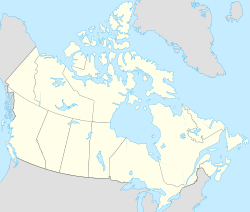Iqaluit
|
Iqaluit ᐃᖃᓗᐃᑦ Frobisher Bay |
|||
|---|---|---|---|
| City | |||
| City of Iqaluit | |||

Iqaluit in March 2010
|
|||
|
|||
| Coordinates: 63°44′55″N 068°31′11″W / 63.74861°N 68.51972°WCoordinates: 63°44′55″N 068°31′11″W / 63.74861°N 68.51972°W | |||
| Country | Canada | ||
| Territory | Nunavut | ||
| Region | Qikiqtaaluk Region | ||
| Electoral districts |
Iqaluit-Manirajak Iqaluit-Niaqunnguu Iqaluit-Sinaa Iqaluit-Tasiluk |
||
| Settled | 1942 | ||
| Village status | 1974 | ||
| Town status | 1980 | ||
| City status | 19 April 2001 | ||
| Founded by | Nakasuk | ||
| Government | |||
| • Type | Iqaluit Municipal Council | ||
| • Mayor | Mary Wilman | ||
| • MLAs |
Monica Ell Pat Angnakak Paul Okalik George Hickes |
||
| Area | |||
| • Total | 52.50 km2 (20.27 sq mi) | ||
| Population (2016) | |||
| • Total | 7,740 | ||
| Demonym(s) | Iqalummiut | ||
| Time zone | EST (UTC-5) | ||
| • Summer (DST) | EDT (UTC-4) | ||
| Canadian Postal code | X0A 0H0, X0A 1H0 | ||
| Area code(s) | 867 | ||
| Telephone Exchanges | 222 (mobile), 975, 979 | ||
| NTS Map | 025N10 | ||
| GNBC Code | OATRP | ||
| Website | www |
||
Iqaluit /iˈkæluːɪt/ ih-KAL-oo-it (Inuktitut: ᐃᖃᓗᐃᑦ; [iqaːluit]) is the capital of the Canadian territory of Nunavut; its largest community, and its only city. Until 1987, the city was known as Frobisher Bay, after the large bay on the coast of which the city is situated. In 1999, Iqaluit became the capital of Nunavut after the division of the Northwest Territories into two separate territories. Before this event, Iqaluit was (relatively speaking) an insignificant city and not well-known outside of the Canadian Arctic or Canada, with population and economic growth highly limited. This is due to the city's isolation and heavy dependence on expensively imported supplies as the city, like the rest of Nunavut, has no road, rail, or even ship connections for part of the year to the rest of Canada. The city also has a polar climate, influenced by the cold deep waters of the Labrador Current just off Baffin Island; this makes the city of Iqaluit cold, even though the city is well south of the Arctic Circle.
As of the 2016 census the population was 7,740, an increase of 15.5 per cent from the 2011 census. Iqaluit has the lowest population of any capital city in Canada. Inhabitants of Iqaluit are called Iqalummiut (singular: Iqalummiuq).
...
Wikipedia




